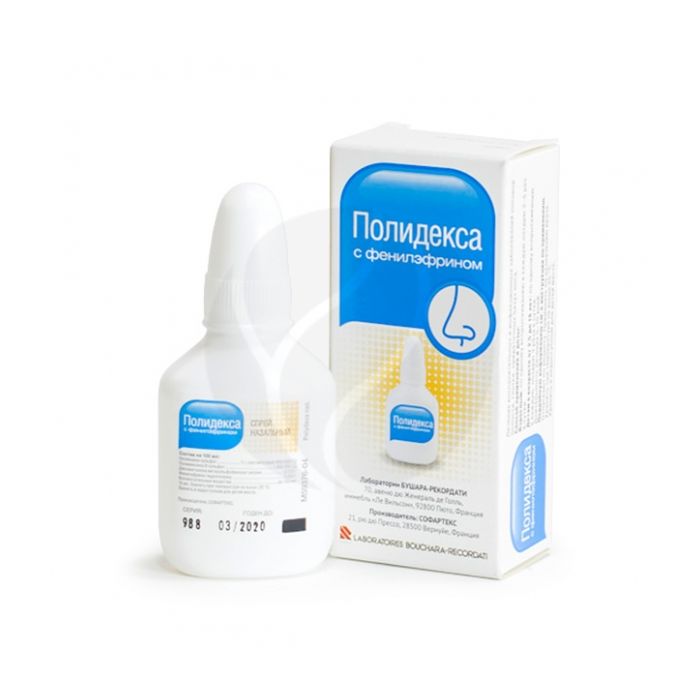Polydex with phenylephrine spray, 15 ml
Expiration Date: 05/2027
Russian Pharmacy name:
Полидекса с фенилэфрином спрей, 15 мл
Inflammatory and infectious diseases of the nasal cavity, pharynx, paranasal sinuses:
- acute and chronic rhinitis;
- acute and chronic rhinopharyngitis;
- sinusitis.
Adults are prescribed 1 injection into each nostril 3-5 times / day. Children aged 2.5 to 18 years - 1 injection into each nostril 3 times / day. The duration of treatment is 5-10 days. During the injection of the drug, the bottle should be kept in vertical position with spray upwards.
Nasal spray in the form of a clear, colorless liquid.
100 ml
dexamethasone sodium metasulfobenzoate 0.025 g
neomycin sulfate 1 g (650,000 IU)
polymyxin B sulfate 1,000,000 U
phenylephrine hydrochloride 0.25 g
Excipients: methyl parahydroxybenzoate - 0.1 g, lithium chloride - 0.34 g, citric acid monohydrate - 0.28 g, lithium hydroxide - 0.1 g, macrogol 400 - 5 g, polysorbate 80 - 0.2 g, purified water - up to 100 ml.
suspicion of angle-closure glaucoma;
simultaneous use of MAO inhibitors;
viral diseases;
kidney disease accompanied by albuminuria, renal failure;
pregnancy;
lactation (breastfeeding);
children's age up to 2.5 years;
hypersensitivity to the components of the drug.
The drug is used with caution in patients with arterial hypertension, ischemic heart disease, hyperthyroidism.
pharmachologic effect
Combined preparation for topical use in otorhinolaryngology. Dexamethasone has an anti-inflammatory effect on the nasal mucosa, neomycin and polymyxin B have an antibacterial effect. Dexamethasone is well absorbed when applied topically, its absorption increases with inflammation of the mucous membrane. When these antibiotics are combined, the spectrum of antibacterial action on the majority of gram-positive and gram-negative microorganisms that cause infectious and inflammatory diseases of the nasal cavity and paranasal sinuses expands.
Pharmacokinetics
Data on the pharmacokinetics of the drug are not provided.
Side effect
Local allergic reactions are possible. In case of unusual reactions, the patient should consult a doctor about the advisability of further use of the drug.
Application during pregnancy and lactation
The drug is contraindicated for use during pregnancy and lactation (breastfeeding).
Application for impaired renal function
The use of the drug is contraindicated in kidney diseases accompanied by albuminuria.
Application in children
Contraindicated in children under 2.5 years of age.
special instructions
Do not use for washing the paranasal sinuses. Avoid getting the drug in the eyes. In case of accidental contact with the eyes and other mucous membranes, rinse immediately with plenty of water. It should be borne in mind that the drug contains components that can give a positive result during doping control in athletes.
Influence on the ability to drive vehicles and use mechanisms
There is no data on the negative effect of the drug on the ability to drive a car and other vehicles.
Overdose
Due to the low degree of absorption into the systemic circulation, overdose is unlikely.
Drug interactions
Drug interactions are due to the phenylephrine content. Phenylephrine reduces the hypotensive effect of diuretics and antihypertensive drugs (including methyldopa, mecamylamine, guanadrel, guanethidine). If such a combination cannot be avoided, medical supervision is necessary. No clinically significant interaction of the drug with other drugs has been identified.

